"Cushions were stolen from my coach; but left a bear carpet, probably for a short time. "
A.S. Pushkin
Instead of the preface
Okay, let's remember what kind of anti-thefts there are in the world. And try to figure out what's what.
What kind of anti-theft is in nature?
In the very first approximation, they can be divided into two classes - electronic and mechanical.
The difference between them follows from the names. Electronic - this, roughly speaking, those that connect to the electrical nodes of the car, so that by the owner's command to block their normal operation. And - these are special locking devices that mechanically interfere with the hijacker, for example, turn the steering wheel, open the door or turn on the desired gear.
Which are better? And what is better for protecting a home - a good door lock or an electronic system with access to a remote control room? One does not exclude the other. Although the choice of electronics is incommensurably broader.
Often electronics acts as a duet with mechanics. So, the mechanical gearbox, equipped with an electric drive, actually becomes electromechanical: it unlocks is no longer the key, but the command from the key ring or from the keyboard. A vandal-resistant ignition lock on Samara or UAZ overgrown contact groups and wires, also occupying an intermediate position between the mechanics and electronics. Still there are blockers of the brake system, which for many years have been leading a semi-legal existence.
In addition, individual installers like to use exotics. To put a gas in the salon, to glue the thief to the seat ... Handicraft sometimes pleases with products, plugging the exhaust system of the engine. And still known biometric systems that recognize the fingerprints of the owner.
Personally, I most like the so-called immobilizers - they do not make any noise and do not blink the bulbs, but simply block the operation of any electronic circuits, waiting for the owner's order to remove the object from the guard.
It is important to note that the steal resistance is determined not only by the circuit design incorporated in this or that system, but by how correctly it is installed in a specific car. Accordingly, the same system can behave differently. That's why in practice any anti-theft, installed in the car showroom for a brand-new car, as a rule, stupid in fact - they mount quickly and, as they say, under a carbon paper. Imagine an installer who, for the whole day, adds the same anti-theft devices to the same cars. Agree that it is simply not serious to expect creative approach from him. And for a hijacker, such a car is a gift of fate.
Mechanics differs from electronics not only in the way of car protection, but also in a completely different variety of model range. Each mechanical anti-theft is initially designed to protect a specific object, whether it is a steering shaft, a hood, a gearbox, doors, a pedal assembly, wheels. But if one and the same electronic system, as a rule, can be installed at least in Samara, even on Maybach, while protecting completely different electrical circuits, the mechanics are made strictly for a specific purpose. For example, the gearbox lock for VAZ-1118 can not be installed on GAZ-31029.
And another important difference between mechanics and electronics. Mechanics need to be installed strictly according to the pattern - then liberties are inadmissible. Therefore, all the locks of one firm will be equally mounted on all models under the same brand, for example Skoda. But the electronics of a good master will always try to install with a twist, not allowing repetition.
And what is telematics?
As you know, an intelligent person is one that can describe Angelina Jolie without running her hands through the air. So with telematics the same difficulties - how to explain what it is and why?
If very briefly, then the telematics is a very hefty anti-theft. A kind of smartphone next to a regular phone. That is, a device that protects against theft for a long time attributed to secondary functions, offering instead navigation, remote diagnostics, multimedia functions, communication and something like that.
The car owner is always available information about the location of the car at LBS base stations with an accuracy of 250 meters and the history of events for the period of interest in the smart magazine. Well, and so on. A potential hijacker, I suppose, will get scared and run away.
Why is all this necessary? Well, suppose that your lady "broke down" somewhere away from home and cuts off the phone: save, dear! But to explain where she stopped, she can not: what is this highway and where are kilometer posts - is unknown. But you will understand quickly, looking at the screen of any suitable gadget, familiar with the Internet. Moreover, the machine itself reports via GPRS channel its coordinates determined by GPS and GLONASS.
The same goes for prevention. will connect to the CAN bus, constantly collecting a database on the behavior of the machine on the road. These data will go to the dealer - let him think, for example, why I have a light in front of my nose. In the event of an accident, the information may be needed by the auto insurers and the traffic police - you can always find out whether the turn signal was turned on at the time of the accident, how the acceleration changed, at what point did the driver slow? For this, the machine issues information to the server of the manufacturer of the telematics complex, and from there it is already transferred to dealers, insurers, traffic police, etc.
How is this arranged? Roughly speaking, the telematics complex is a box of the "black box" type, collecting information, as well as online service. The brain constantly collects information that is only accessible to it, and the language communicates it to the interested parties. Ears, in turn, inform the brain of the wishes of the host.
Do you need telematics personally for you? Again, I will remember about the smartphone. If you just need to talk or exchange messages, then he does not need you. But if you want to turn your finger over the screen pages, rummage on the Internet, use navigation, take pictures and listen to music at the same time, then the usual phone is not enough for these purposes.
However, the question is no longer worth it. It seems that there will not be any other "guardians" soon!
In addition, telematics is able to direct me, if necessary, to the nearest service with a car, where we will be repaired, refueled and screwed up. Very good, but not every service, store or gas station will fall into this list. In other words, I will necessarily be manipulated. And to serve me will not be where it's good, but there who paid the time for such a "navigation".
And hello, dear readers! Remember, not so long ago, in one of the articles we talked about an immobilizer - an electronic device preventing the theft of your vehicle? So, today it will be all about the same anti-theft systems, but this time not electronic, but mechanical.
From the previous view, they are distinguished only by the contact method of opening (with the help of a key and only from inside the car), ie it is impossible to disconnect from a distance. Many drivers, because of this, consider mechanical systems more reliable than electronic ones, which in the event of network failures block all vehicle systems and no one else is going anywhere without the help of a specialist.
Of course, there are motorists who are skeptical about mechanics, they say, the intruders can simply dismantle the device, but I hasten to reassure you - it's not so simple. All companies producing such anti-theft systems, complete their locks with "stalled" screws, which have a special bonnet, which breaks down during installation and in the future it is impossible to unscrew the screw. About detailed work of mechanical security systems, we will discuss further.
What is a mechanical anti-theft system
Mechanical anti-theft system- this, in fact, mechanical gearbox and steering lockers, in the form of pins, screws and other devices that interfere with their operation. Such systems, in our time, differ significantly from their ancestors of the 90s (which was only the "crutch" on the steering wheel). But the history of anti-theft systems originates from the time of the creation of the first cars, and more specifically since 1886. Then, such a novelty of the transport world was affordable only to wealthy people, often causing envy in the rest. It is not surprising that many not very respectable citizens just dreamed of hijacking a car.
 So for the first time was the question of how to protect the owners of their cars. Of course, there was no need to talk about any electronic methods of protection at the end of the XIX century, so the only affordable option for protecting the machine was the use of mechanical anti-theft devices, some even "survived" to the present day. Thus, drivers used locks, plugs and other improvised objects as locks of steering columns, door locks, the installation of which interfered with the operation of the car and thereby protected it from theft.
So for the first time was the question of how to protect the owners of their cars. Of course, there was no need to talk about any electronic methods of protection at the end of the XIX century, so the only affordable option for protecting the machine was the use of mechanical anti-theft devices, some even "survived" to the present day. Thus, drivers used locks, plugs and other improvised objects as locks of steering columns, door locks, the installation of which interfered with the operation of the car and thereby protected it from theft.
Interesting fact! The first Peugeot car was stolen in 1889 from a French baron directly from a personal garage.
The first mechanical anti-theft did not require a special installation and had a hinged character. A little later, the protective systems began to be built into machines directly at the manufacturers' factories, it also became possible to put such a device in private workshops. An alternative option to mechanical safety systems appeared only after the Second World War - electronic devices appeared in production.
Types of mechanical anti-theft systems
All existing mechanical anti-theft systems are divided into three types: Anti-movement of the car, protecting from penetration inside the machine, blocking various working units. To the devices that are suitable for the movement of the vehicle, first of all is the propeller shaft lock, which is mounted on rear-wheel or all-wheel drive vehicles and consists of a locking and power element. The first is located in the cabin of the car, the second - under its bottom. The main function of such a blocker is to prevent rotation of the propeller shaft, which makes the vehicle stationary.
![]() Common, in our time, are also anti-theft systems designed to protect the internal contents of the car by locking the doors of the cabin, trunk and hood. Typically, this type of protection is installed at the factory, and most often an electromagnetic protection system is used, in addition to which mechanical elements can be installed. So, for example, to avoid the possibility of disabling the electronic security system, using the connector under the hood of the car, it makes sense to additionally install a mechanical device that protects the hood. Basically, such a device is supplied with a cable in a flexible shell, which prevents the breaking of the staff lock.
Common, in our time, are also anti-theft systems designed to protect the internal contents of the car by locking the doors of the cabin, trunk and hood. Typically, this type of protection is installed at the factory, and most often an electromagnetic protection system is used, in addition to which mechanical elements can be installed. So, for example, to avoid the possibility of disabling the electronic security system, using the connector under the hood of the car, it makes sense to additionally install a mechanical device that protects the hood. Basically, such a device is supplied with a cable in a flexible shell, which prevents the breaking of the staff lock.
And finally, the most popular mechanical anti-theft devices are devices that interfere with the operation of various working units. There are two main types of such devices: the task of some is to block the transmission, while others must fix the steering wheel and do not allow it to rotate. Both types are installed both in the standard order, and additionally.
To lock the gearbox, next to the switch lever, there is a hole in the car in which a metal pin is inserted, equipped with a corresponding lock, so that it can be pulled back only by using a key. This device is suitable for both manual transmission and automatic. If you have a mechanic, the pin will block all transmissions, except the back, and on the box the machine will not let you change the parking mode and the car will not move from the spot. In addition to the pin plugs, today it is possible to equip the machine with bush-free designs using built-in locking mechanisms. Such devices will not allow you to move the gear lever (or block the selection of gears), and you can open (close) the mechanism only with a key, the lock of which is located on the dashboard or between the front seats.
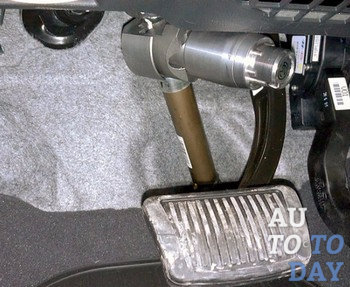 Lockers of the steering column, in the regular mode, are equipped with almost every car produced today. The principle of its action is the following: the mechanism connected to the ignition lock, if there is no key in it, restrains the steering wheel and does not allow it to rotate. The truth is there is one pretty serious shortcoming - it does not have the proper strength and in the case of a sharp rotation of the locked steering wheel it can be broken.
Lockers of the steering column, in the regular mode, are equipped with almost every car produced today. The principle of its action is the following: the mechanism connected to the ignition lock, if there is no key in it, restrains the steering wheel and does not allow it to rotate. The truth is there is one pretty serious shortcoming - it does not have the proper strength and in the case of a sharp rotation of the locked steering wheel it can be broken.
Many drivers use additional hinged mechanisms of the steering wheel lock system. They have the form of a clutch (attached to the handlebar) with a corkscrew connected to it, which is located above the dashboard and limits the steering rotation. The whole mechanism is equipped with a lock that opens with a key. Perhaps some motorists believe that this construction is not very reliable, and the lock, if desired, can be opened, but believe me: this is quite problematic. It's rare that a hijacker, having noticed such protection, wants to mess with the car, because you can find another, which will be easier to steal. Thus, it should be noted also the positive psychological effect of the use of the rudder blocker.
Less common are the pedaling lockers and the "secrets" on the wheels of the car. The essence of the latter is the presence of a non-standard bolt, which can be unscrewed only with the key of the right size, and it, of course, is only the owner. It should be noted that most mechanical anti-theft systems have a fairly simple design, but despite this, many years in a row, qualitatively fulfill their main task - protect cars from criminals.
How to choose a mechanical anti-theft system
 As you have already noticed, today there are many types of anti-theft automotive systems of a mechanical type. All of them are quite diverse and begin with a stick-blocker of the steering wheel, ending with a lock to lock the pedals. Deciding to equip your car with a mechanical protection system, you first need to determine what specifically you will install: only the steering lock or, perhaps, it is better to lock the gearbox, but suddenly, the efficient will stock up all at once and prevent the attacker from even getting into the car. Well, the last option is the right one, after all a reliable anti-theft system must consist of three parts:
As you have already noticed, today there are many types of anti-theft automotive systems of a mechanical type. All of them are quite diverse and begin with a stick-blocker of the steering wheel, ending with a lock to lock the pedals. Deciding to equip your car with a mechanical protection system, you first need to determine what specifically you will install: only the steering lock or, perhaps, it is better to lock the gearbox, but suddenly, the efficient will stock up all at once and prevent the attacker from even getting into the car. Well, the last option is the right one, after all a reliable anti-theft system must consist of three parts:
- depriving the thief of the opportunity to penetrate inside the machine (door, hood and trunk blockers);
Deprivation of the possibility to start a car (non-standard blocking of circuits, electromechanical locking of the hood);
Do not let go (lock the gearbox, steering wheel, pedals)
Based on this, you will have to purchase all of the listed types of mechanical interlocks. But if you decide to buy, for example, only a mechanical gearbox lock, should pay attention to such important points:
- it should work only in conjunction with the alarm system;
Lock the lock on the gearbox must be made of strong metal, which will give it some anti-vandal resistance and protect it from drilling and sawing;
It is better to pay attention to the universal gearbox lock, suitable for different brands and car designs.
This type is considered one of the most reliable ways of mechanical protection of your car (not counting the complex installation), and the choice of a particular transmission lock system depends on the model of the car and the capabilities of your budget.
In total, choosing a specific device of a mechanical anti-theft system should be based on your needs. So, by example, if the car remains overnight in a parking lot or under the windows of the house, in addition to the alarm, first of all, you should buy a bonnet and steering lock.
Installing a mechanical anti-theft system
Depending on the type of mechanical anti-theft system you have chosen, different stages of installation of a device are distinguished. Consider the process of installing the most common of them: gearbox interlocks and steering shaft.
 Mechanical lock-blocking gearbox is divided into universal and model. More preferable for installation are model blockers, as they are selected individually for each model of the car, taking into account all the details of locking and installation, which will help to avoid problems during the installation process. The set of this device includes an instruction in which the entire process of its installation is described in detail, and given the lack of the need to interfere with the design of the transmission, even a novice motorist will be able to cope with the installation.
Mechanical lock-blocking gearbox is divided into universal and model. More preferable for installation are model blockers, as they are selected individually for each model of the car, taking into account all the details of locking and installation, which will help to avoid problems during the installation process. The set of this device includes an instruction in which the entire process of its installation is described in detail, and given the lack of the need to interfere with the design of the transmission, even a novice motorist will be able to cope with the installation.
Universal lockers are suitable for almost any vehicle, but are most often installed on older car models. In this case, you need experience in this area and knowledge of all the subtleties of the mechanism of the checkpoint. Unlike the installation of the previous type of bollards, installation of a universal ooochen is desirable to entrust to qualified specialists. Installation of the steering column blocker is often not so serious and includes the following steps:
- locking the steering wheel with an anti-theft device;
Mounting the coupling parts on the steering shaft (if it is properly oriented, the stopper can easily enter and exit from its groove);
Unlocking the steering wheel and removing the stopper;
Clamping of clutch mountings, it should not interfere with the free rotation of the steering wheel;
Fastening of the plastic holder to the driver's seat (a locking lock is inserted into it, when it is not necessary to block the steering shaft).
Installations of different types of blockers on different models of cars are very different from each other and all their nuances simply can not be described in one article, and given the complexity of the installation process, it will be logical to turn to special service centers in general.
Subscribe to our feeds in
The desire to keep your property intact is completely natural and understandable. Moreover, if this car - a friend, helper and livelihood. But this is for the car owner. For others, it's a purse full of money on the road. It is only necessary to take it and carry it away unnoticed.
Whatever this "invisible" has turned out, a great many obstacles have been invented - from articles in the Criminal Code, to satellite signaling. The likelihood of hijacking as existed before, so it exists now. And neither dialogue coding nor the best steering lockers can cope with it. Maximum on what all the best wonders of the technique of protection against theft are capable of - complicating the hijacking process. Make the hijacker think about what to spend a hot night at. Decide on a complex hacking or search for a car with technical wonders easier.
The car owner just needs to know - how to choose how to install a steering lock and how, at the same time, save money?
Reliability of mechanical protection
 From the last decades of the last century to the present, the evolution of various means of protection against theft continues. Every time militant marketers informed the world about the victory over the dark forces stealing cars. Be sure to mention both selected gadgets and promising samples. Meanwhile, production continued to evolve and strain the minds of its engineers with the latest ideas.
From the last decades of the last century to the present, the evolution of various means of protection against theft continues. Every time militant marketers informed the world about the victory over the dark forces stealing cars. Be sure to mention both selected gadgets and promising samples. Meanwhile, production continued to evolve and strain the minds of its engineers with the latest ideas.
At this time, the owners of cars went, in their understanding of the situation, not in a consistent way - from better to better, but parallel - all at once and more. The only thing holding them back is the question of how to choose the best among the known samples. The trend of complex protection against theft prevails over the remaining options. Since simply "best" protection of the car, with a 100% guarantee, does not exist, then the question - how to choose, remains relevant.
Now that to approach this indicator, the owners of cars provide their pets with a whole set of the best means of protection against theft:
- unique images or specific body painting;
- ;
- car bodies;
- its main aggregates;
- glazing machines;
-
- locks on the gearbox and the gas pedal;
- blocking the steering wheel of the car;
In an unfavorable confluence of circumstances, the attacker, having understood all the coding systems and having started the engine, suddenly discovers that the steering wheel of the car is blocked. Evacuator, he did not cause and nowhere to go straight. That's how the last redoubt of the owner's defense begins to work.
Types of mechanical protection of the steering wheel
Can I talk  that this redoubt will hold its own defense site? Of course not. But he is able to take away from the attackers that, albeit insignificant, part of the time, which they cherish most. This part of the time, perhaps, will be equal to the price of life or a ruined fate. How to choose the method of hacking in a specific situation?
that this redoubt will hold its own defense site? Of course not. But he is able to take away from the attackers that, albeit insignificant, part of the time, which they cherish most. This part of the time, perhaps, will be equal to the price of life or a ruined fate. How to choose the method of hacking in a specific situation?
Each part of the steering wheel locker has this part of its time, depending on the material used in its manufacture, the quality of the mechanism and its design. What to choose from the existing 3 varieties:
- The steering lock (wheels);
- The rudder block (axle);
- The rudder block (mechanism).
These varieties are described in more detail below.

On the rudder axis


Important: simultaneous installation of several types of protection on the steering wheel of the machine does not make sense. Their functional purpose is the same. Only the rudder lock (axle) is much safer.
How to make the right choice and what to do
 How to choose a steering lock and not to lose? Difficult in choosing any gadget is nothing ordinary. Everything is simple and simple. The rudder protection consists of a bearing base and a locking device with a secret locking mechanism:
How to choose a steering lock and not to lose? Difficult in choosing any gadget is nothing ordinary. Everything is simple and simple. The rudder protection consists of a bearing base and a locking device with a secret locking mechanism:
- door lock;
- lock body - bearing base;
- its tongue is a blocking device;
- larva is a secret mechanism;
- rudder lock (axle);
- bearing base - two coupling halves that are fixed on the axis of the steering wheel;
- blocking device - locking mechanism, inserted into the coupling, when locking;
- on the steering wheel (wheel);
- bearing base - a rod of complex shape with a locking clutch, mounted on the rim and spokes of the steering wheel;
- blocking device - the lock of the lock, inserted into the coupling, when locked;
- secret mechanism - key or keyless;
To have an idea of how to choose the best, it means to be sure that:

Important: the leather case will avoid the constant rumbling of the steel parts of the steering lock in the "glove box" or the pocket of the door.
The best models
After the selection criteria are outlined and it became clear how to choose the best steering locker, you should demonstrate this with examples of popular models. The location of their installation and the main technological methods for this are identical: Buy http://wheellock.ru/blokirator-zaslon/.
"Python"
In addition to the models presented, there are also others that deserve attention, one such model is rudder locker Arkan.
Important: the main principle of the best installation of the mechanism is the conformity of the shape of the coupler to the form of the shaft. In the absence of such a correspondence, a plot with a rotation of the clutch around it is likely. A similar case will correspond to the open position of the car steering lock.
The presence in the car of such a means of protection against theft as a rudder lock, certainly increases its anti-theft properties. But consider it the main - there is no reason. The brigade of professional hijackers will be ready for the presence of such protection. Most of the small and medium-sized criminal professionals will refuse to steal such a car.
Mechanical anti-theft devices - can they reliably protect the car? Consider the types of blockers, the device and the degree of protection. Earlier we already considered,. Recall that anti-theft means, from the point of view of functionally intended, prevent the penetration or movement of the car (including in tow).
Classification
Mechanical anti-theft systems for cars can be divided into two types:
- stationary - is mounted to the controls of the car, are activated automatically or manually by means of the installation of the response part;
- portable locks - installed and removed by the driver each time manually.
Stationary means include:
- additional bonnet locks;
- gear selector blocking device;
- steering wheel lock;
- additional door locks.
The advantage of this type of device is that it can be both a separate stage of protection, and an additional device in the complex security system. For example, you can lock the gearbox selector manually with a separate key or power additional bonnet locks so that they fire automatically when the car is armed.
Mobile mechanical anti-theft devices:
- device for locking the pedal unit.
Advantages of removable means in their cost, there is also no need to make changes in the design of the car. The payment for this becomes inconvenience in use, since you will constantly have to install and remove the protection. Do not forget that many of these blockers are massive enough, and therefore keeping them at hand is not always convenient. 
Hood Locks
Access to the hood of thieves is necessary to muffle the sound of the alarm (often the siren is poured with a mounting foam or simply broken), access to the engine ECU, the replacement of which in some cars allows you to then start the car without problems. Also, let's not forget the trivial case of hacking the hood to steal the battery.
Of the most effective means can be identified pin lock. Two pins are mounted at the front, which, when the hood is closed and the car is armed, is locked by electric locking mechanisms installed in the hidden cavity of the "TV". On the pins must necessarily be wearing plastic cylinders. If the thief tries to cut off the pin, the plastic casing will simply start turning. Such a method of protection has repeatedly proved its effectiveness. If you buy a really high-quality mechanism, then the thief will not help either a special cushion for unlocking the doors, no metal sawing, no scrap and brute force.
The second type of hood protection system involves a mechanical locking of the bonnet's regular lock. The driver, before leaving the car, presses the locking mechanism installed in the cabin, after which the hood lock is no longer open with a regular lever. Unlock the device using a conventional key, which causes the main drawback of a system of this kind - a weak cryptographic protection of the locking mechanism. When hijacking, the simplest larvae can be cracked using the bumping method or with the help of skeleton keys.
Additional door locks
The design of the locking mechanisms resembles the hood protection system. Activation of actuators occurs when the vehicle is armed.
To feed such devices it is necessary only at the switched off ignition. This will prevent the spontaneous operation of the system during an accident.
The main feature is that if you power the pin locks, for example, from a cheap alarm, then there will be little sense in trying to steal them. Hijackers can intercept the signal, which will easily deactivate the staff TZ, and with it the door locks. 
If you use this type of protection, then only in conjunction with the alarm, protected by a dialogue code. It is best to "tie" additional pins to a separate label with protection against retransmission. Unlocking of locks will be carried out only if there is a mark in the reading zone.
Transmission selector blocking
From the theft of this method protects by simply blocking the selector lever or the gear lever in the gearbox. Locking mechanism can be carried out manually or be connected to the vehicle's standard security system. Using a conventional lock lar greatly impairs the cryptographic protection of the locking mechanism. In addition, the larva is usually located in close proximity to the selector, which makes it noticeable. The blocking (power) mechanism itself is hidden under a plastic cover, which, when hijacking, prevents access and a mechanical method of breaking.
Steering lock
Closes the list of stationary mechanical anti-theft devices, the steering lock, which is mounted under the steering column or near the pedal unit. System setup:

Anti-theft systems for cars clamp the steering shaft clutch, which consists of two parts. The coupling rotates with the steering wheel and in no way gives its presence. To activate the device, the driver must insert a stopper in the groove and lock the device. After this, when the steering wheel rotates, the stopper on one side will rest against the motor shield, and on the back side into the pedal assembly. If, before leaving the car, the driver blocks the steering wheel with a regular mechanical anti-theft device, theft of the car will require much more time and effort.
The most effective are mechanical anti-theft devices using instead of a grub and a key a secret. In the field, it is possible to dismount such a blocker with a saw blade. Fortunately, the saw is not included in the standard set of tools used for theft. And so we can safely say that such a mechanical blocker will scare away the thief, keeping the car in your property.
Removable steering lock
 An anti-theft device is worn on the rim of the steering wheel or spoke. The meaning of protection is to prevent rudder rotation when stealing. The answer part of the blocker will rest on the rack or the instrument console.
An anti-theft device is worn on the rim of the steering wheel or spoke. The meaning of protection is to prevent rudder rotation when stealing. The answer part of the blocker will rest on the rack or the instrument console.
Alas, it is not necessary to talk about good cryptographic protection of cheap rudder blockers. Such a tool hinders such a tool more by its appearance, rather than by resistance to burglary. If a mechanical lock is installed on a fairly common model or a car that is not of particular value, then it is simply useless to waste energy on hacking an additional security device.
Among the systems on the market, you can identify a steering lock "Python". The device does not look cheap Chinese hand-made, besides it provides a good level of crypto protection. In addition, the secret used in the construction of the locking mechanism is compact enough that it should not cause any inconvenience.
Protection of the pedal unit
Anti-theft protection of pedals involves 2 types of performance:
- stop, preventing pushing. The disadvantage of such a system is in the inconvenience of installation. On the other hand, when trying to steal, even a bot with weak crypto protection, due to its low location, it will be difficult to break;
- the support, which at one end blocks the pressing of the pedals, and the second clings to the wheel. An anti-theft device is easier to install, but often quite massive.
Mechanical anti-theft devices, they are also blockers, are special devices for blocking certain parts and auto parts, the main task of which is to prevent unauthorized penetration, control and movement.
They can be very different: removable and stationary; universal or adapted strictly for a specific model and brand of cars; act as an integral part of the whole security complex or a separate protection measure. However, most often blockers are divided by the type of devices that they block. We will consider this classification. By the way, earlier I already wrote about anti-theft systems.
1. The checkpoint blocking device.
The most common mechanical anti-theft device for cars and quite effective. Can be external and internal.
The external blocker works according to the following principle: the gearshift lever is set to a certain position, as a rule, it is the rear gear, and is fixed (immobilized) in it. In this case, the blocking device itself can have both simple and complex shape, be pin or bezshtyre (arc).
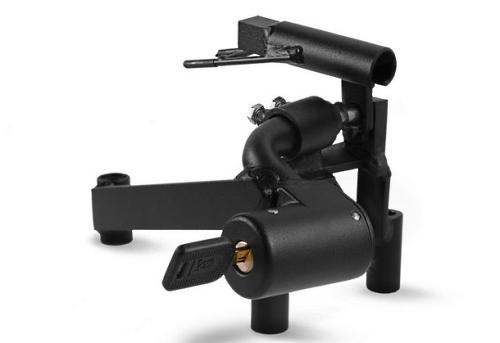
The internal blocker requires intervention directly into the gearshift mechanism itself, so it is not visible in the passenger compartment. Hidden under the casing of the central tunnel device produces only the larva of the lock, located at the gearshift lever. The principle of operation of the internal blocker is similar to the principle of the external blocker, just the blocking in them is carried out in different ways.
The main disadvantage of these mechanical devices is that they do not exclude the possibility of towing a car on which they are installed, with a squeezed clutch. The exception is cars with an automatic box in which the lever of the last is moved to the "parking" position.
Their advantages:
- high resistance to hijacking (subject to installation by professionals, the blocker must necessarily be internal).
2. The rudder lock.
The principle of operation of this device is as follows: the steering wheel is fixed in one position and turn it, and therefore - and change the trajectory of the machine, it is impossible, even with the engine running. The same immobilizer of the steering wheel is attached to either the steering wheel or the steering wheel and one of the car's pedals.
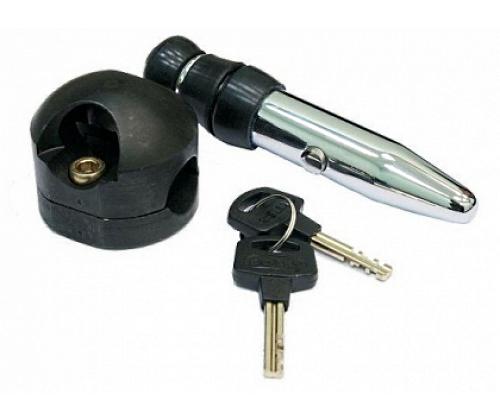
Pros of these mechanical devices:
- low cost.
Minuses:
- a low degree of protection of the car from theft.
It is most justified to use the steering lock in crowded places, only during daylight hours and provided that you leave for a short while.
3. Wheel lock.
It is a structure made of strong steel, with which the wheels are fixed from the movement. This device is very reliable, because it can be eliminated only with a special tool (cutter, Bulgarian), however, it is not very popular with car owners, because it has too many drawbacks.
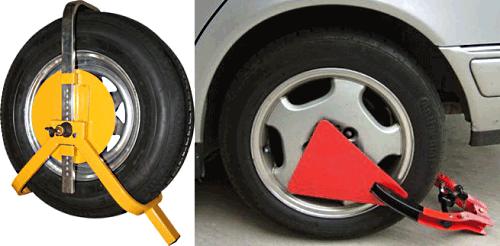
Disadvantages of the wheel lock:
- bulkiness;
- unattractive appearance;
- the need for regular cleaning and uncleanliness, which causes special troubles in bad weather.
Pluses:
- the highest efficiency (but only if the device has a wheel release protection that will prevent the wheel from being replaced by a spare wheel);
- independence from the electronics of the car.
4. Anti-theft ignition locks.
A great alternative to regular ignition locks, combining the functions of the latter, the functions of the anti-theft lock, a number of service functions and the protection of the starter.
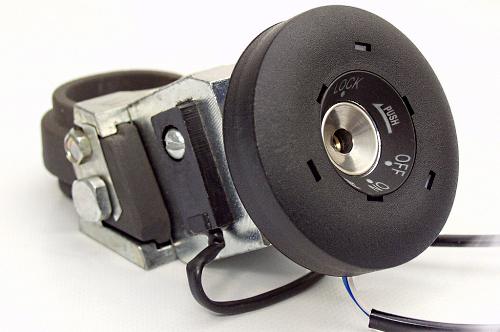
Pros of the anti-theft ignition locks:
- a decent degree of protection from the selection of keys, opening a master key;
- a high level of secrecy - more than 1 billion combinations.
Minuses:
- require replacement of the standard ignition switch.
5. Door interlocks.
Look like an additional hidden latch in the regular mechanical door locks. Usually have protection against opening by a metal ruler (master key).
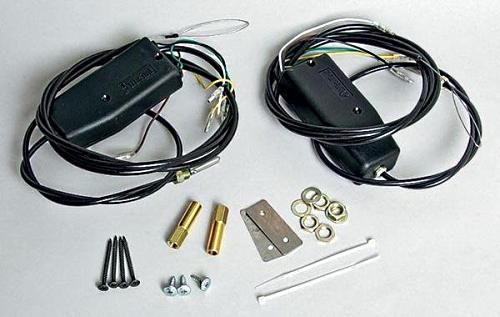
Disadvantages:
- will not save from penetration into the car through broken glass;
- high installation cost, because implies the protection of all car doors.
6. The bonnet lock.
This device looks like a very strong cable, complete with a locking device, which for better security is better to display in the interior, and not leave outside. As an independent means of protection, this mechanical anti-theft device is ineffective.
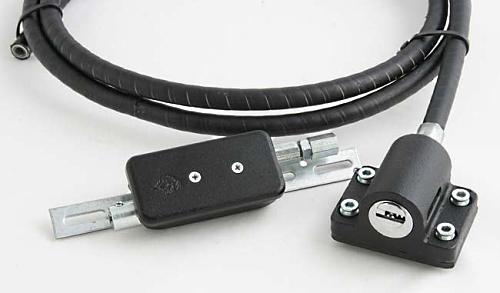
There are two types of hood blockers:
1. Mechanical.
Mechanical hood blocker has a classic locking device with a larval key. Advantages of such a device consist in its simplicity and reliability, as well as electronic independence (the presence of current in the electrical circuit does not affect its efficiency in any way). Disadvantages: has small difficulties in installation; there is the possibility of opening a master key, a drill, etc.
2. Electromechanical.
Such a device consists of: locking mechanisms, wiring and electric drive, and control it with the help of signals from an electronic device: alarm, immobilizer, digital relay. The first option is the most common.
Pros of electromechanical hood blockers:
- simplicity of installation;
- ease of use.
Minuses:
- communication with signaling;
- dependence on the electric circuit of the car (with a discharged battery, it is impossible to open this locking device).
7. The brake system blocking device.
It looks like a small block with a check valve that cuts into the brake circuit (one or two). This device is turned on and off mechanically (using a key), the security of the lock lar determines the reliability of the lock. Its main task is to protect the car from theft.
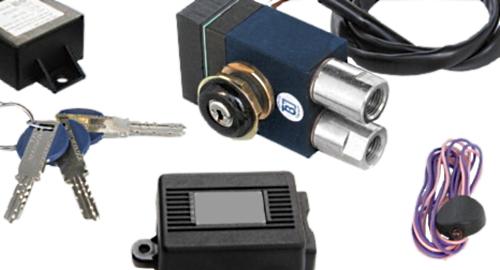
Disadvantages of the mechanical device under consideration:
- high price;
- need for intervention in the braking system.
Pluses:
- neutralize the blocker can only be cut through the brake hose, which is unlikely to risk anyone doing.
